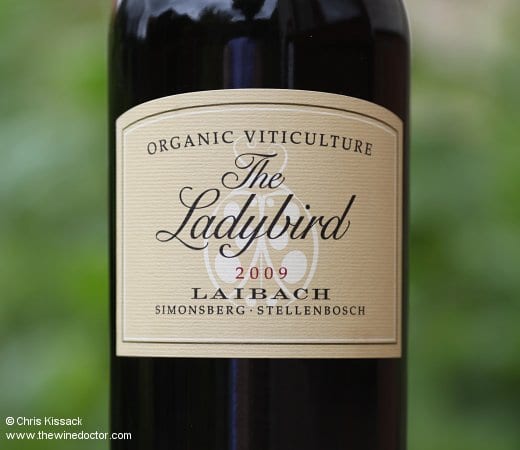Laibach The Ladybird 2009
One of the curious features of the natural wine fairs recently held in London is the very poor turn-out from South Africa. With a wonderful climate and lots of long-established vineyards full of aged vines with deeply secured roots, you would have though this would be an ideal spot for organic or biodynamic viticulture, perhaps accompanied by a little ‘natural’ winemaking. Apparently not it seems, at least if the natural wine fairs are anything to go by. At the RAW Wine Fair, arranged by Isabelle Legeron there was not a single representative of this country. And at the Real Wine Fair, a showcase of domaines and wines marketed within the UK by Les Caves de Pyrène, there was just one South African, Craig Hawkins. Craig was showing the wines of Lammershoek, where he is responsible for winemaking, as well as from his own personal project, Testalonga. But that’s it. One name out of – looking at a combination of both fairs – about 300 producers present.
It seems unlikely to me that this is a true reflection of the South African wine scene. And just a quick scan through my samples lined up for tasting revealed this bottle, The Ladybird, from Laibach, a long-established (but divided and renamed) winery in Simonsberg near Stellenbosch. Now even my basic wine knowledge (and beyond Bordeaux and the Loire, it perhaps is rather basic) tells me that Simonsberg and Stellenbosch are definitely in South Africa. And the label – pictured below – doesn’t leave much room for doubt as to the organic nature of the viticulture on this estate. Whether or not it would qualify as ‘natural’ wine or not is a moot point. How do you define a ‘natural’ wine anyway?

Laibach dates back to 1818, when the estate was founded by Daniel Johannes van Ryneveld, who was originally from Amsterdam. His estate was vast, enclosing most of the valley created between the Simonsberg, Kanonkop and Klapmutsberg. Unsurprisingly perhaps it was subsequently divided, and one of the three estates this created was ultimately acquired by Friedrich Laibach in 1994. Friedrich and his daughter Petra Laibach-Kuehner revitalised the estate, replanting 37 hectares of vineyards with a broad spread of varieties, including the inevitable Pinotage and Chenin Blanc, the main Bordeaux varieties and interestingly some Viognier as well. The conversion to organic viticulture came not long afterwards, when Petra Laibach-Kuehner began to question the sustainability of practices on the estate. Herbicides, pesticides and chemical fertilisers were banned, cover crops were introduced, irrigation was halted and surface weeds are controlled by working the soil.
I haven’t taken a comprehensive look at the wines of Laibach, but if the 2009 Ladybird is anything to go by there is certainly something worth investigating here. I decanted the wine for a couple of hours. In the glass it shows a rich and dark hue, but it is nowhere near opaque. Aromatically it has a slightly surprising freshness and vigour; there is plenty of fruit here, but also an array of savoury aromas which add form and complexity to its profile. The fruit has a very lively character, with a croquant style, reminiscent of red cherry, but not cherries that are soft and sweet, but cherries that are tense, al dente and vivacious. There are tinges of cranberry too, as well as lots of smoky and gritty elements and fleeting nuances of green peppercorn. It is clear that this is no soft and simple, fruit-rich or super-ripe New World wine. There is plenty of substance on the palate, but this is in no way voluptuous or soft. The textured entry and midpalate are more than balanced by a savoury grip and frame, with a biting grip akin to red cherry- and plum-skin, cranberry again, and a freshness imbued by fine acidity. The finish has all the savoury tones expected, the structure dry and sappy. This is delicious; it has the richness and fruit texture of a warmer environment, but I don’t find it excessively sweet. And the structure has a much more reserved, Old World style, with its fresh grip and slightly green tones. Overall this particular palate – even with its Old World, Bordeaux and Loire-leaning prejudices – finds this to be delightful, deeply veined and full of appealing character. Alcohol 14%. 16/20 (4/6/12)
Source: Wine Hound, £12.95 per bottle, £155.40 per case.
